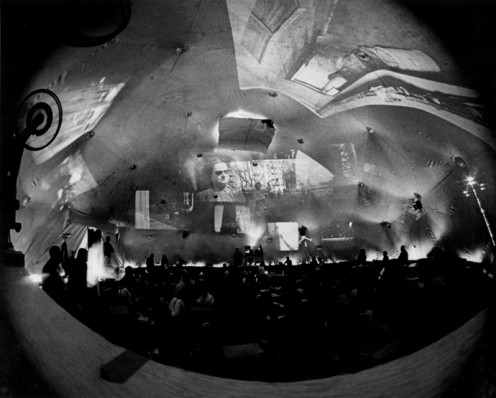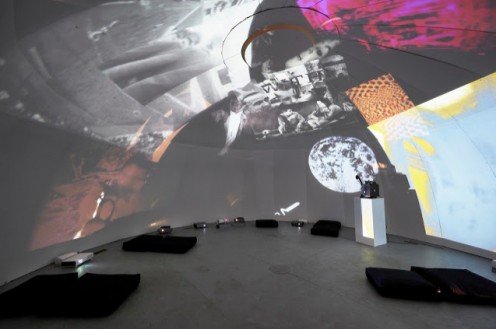Pre-amble
If we were to catalog our age by its temptations, surely it would be called “The Age of Dreams”—and not because we’re sleeping well. Our big vice is the small screen, or so it seems to me when I log in to write and find myself, hours later, wandering down a primrose path of links. (Did you know that the earliest recorded usage of the phrase “primrose path” is in Hamlet? And that there have been two movies called “The Primrose Path,” in 1934 and 1940? Ahem…)
Dreaming, says the dictionary, is the “succession of images, thoughts, or emotions passing through the mind during sleep.” When I am “surfing” I am essentially asleep, at least in relationship to my surroundings and my conscious goals. If I may mix storied paths here, I become like Dorothy, whose progress along the yellow brick road to Oz is halted by sedative poppies. But wait…
That slide I just executed, from the figure of speech “primrose path” to the filmic image “yellow brick road,” has the blurry relatedness of a dream segue or a surfer’s click. The link might have been made through color, skipping from the common phrase “primrose yellow” over the “path” to the “yellow brick road.” Or perhaps it was “road” that triggered the link, via the fact that “a path is like a road.”
Perhaps, as I just made the comment about movie titles, both “primrose path” and “yellow brick road” were in the mental vicinity of the word “movie,” and came close enough for the thoughts to touch. The word “movie” is in mind anyway, as I started on this mental trek in order to figure out why I found Stan VanDerBeek’s film installation Movie-Drome (1963-66) so enthralling. It may be that no one of the above links would have been strong enough for my mind to move from one image to the next; perhaps all the associations were necessary for the signal to reach my conscious mind.
The thought process I just described is, in miniature, the point of Movie-Drome: it is a space purpose-built for colliding images into each other until the pile-up becomes a thought.
The Dream Dome
The Movie-Drome is a domed space (the original installation used the chopped-off top of a grain silo) with fourteen film and two slide projectors ringing the perimeter, all running simultaneously. Viewers lie on the floor, watching the play of images on the dome overhead. Although VanDerBeek imagined a “network” of movie-dromes, drawing from a global image archive, the version in the exhibition “Ghosts in the Machine” at the New Museum featured VanDerBeek’s films, mixed with slide shows of world art and news photos.

The original Movie-Drome, in Stony Point, New York.
VanDerBeek outlined his original idea in a 1966 article for Film Culture magazine, titled “Culture Intercom, A Proposal and Manifesto.” It is worth quoting, so that we can compare what he thought he was doing with the results. After describing the threat to humanity posed by “over-developed technology” joined with “under-developed emotional-sociology,” he proposes:
“That immediate research begin on the possibility of an international
picture-language fundamentally using motion pictures.
that we immediately research existing audiovisual devices, to combine these
devices into an educational tool that I shall call an “experience machine”
or a “culture-intercom”…
“In a spherical dome, simultaneous images of all sorts would be projected on the entire dome-screen…the audience lies down at the outer edge of the dome with their feet towards the center thus almost the complete field of view is the dome-screen. Thousands of images would be projected on this screen…each member of the audience will build his own references from the image-flow…
using the past and the immediate present to help us understand the likely future…
The purpose and effect of such image-flow and image density (also to be
called “visual-velocity”) is to penetrate to unconscious levels and to deal with
and logically understand those levels.”
As VanDerBeek continues the manifesto, he writes that these “emotion-pictures would provide images that inspire basic intuitive instincts of self-realization and inspire all men to good will.” [1]
Is Vanderbeek the “John the Baptist” of the WWW?
That sentiment might sound familiar. VanDerBeek didn’t live to experience image search or even the World Wide Web (he died in 1984, the year personal computers with a graphical user interface first became widely available.) But the details of his vision—he wanted movie-dromes around the world to be connected by satellite and respond to viewer requests for particular images—make it irresistible to see Movie-Drome as prefiguring the Web. As Massimiliano Gioni, one of the curators of Ghosts in the Machine, writes, VanDerBeek wanted “…a space where an international network of databases would share images and films—a cathodic church that today bears a close resemblance to the World Wide Web…VanDerBeek’s Movie-Drome plunges its viewer-patients into a river of images that seems to portend the extreme voyeurism of the Internet.” [2]

Stan VanDerBeek, Movie-Drome, 1963-66/2012
Recreated at the New Museum, New York. Photo: Benoit Paille
Vanderbeek’s prophecy that “emotion pictures” would “inspire all men to good will” sounds almost religious, and in that it was also futuristic. As scholar Marguerite Wertheim writes in The Pearly Gates of Cyberspace, “In one form or another, a ‘religious’ attitude has been voiced by almost all the leading champions of cyberspace…as a new immaterial space, cyberspace makes an almost irresistible target for such longings.” [3]
Or the Salome?
It is the likeness of Movie-Drome to our own time that first grabs our attention—and the vision expressed in “Culture Intercom” does seem uncannily prescient. But it might be the aspects of Movie-Drome that are not Web-like that keep it living and breathing as art. It is effective art, now, unlike some works in the exhibition whose interest is primarily historical. Roberta Smith, art critic for the New York Times, called Movie-Drome “tantalizing,” “an enthralling rediscovery suggestive of a cross between an animated Rauschenberg silk-screen painting and the Internet’s deluge of images.” [4]
We should not be so impressed by Movie-Drome’s similarity to the Internet as to ignore the association with painting. At first glance, it might seem strange to compare VanDerBeek’s extravaganza of moving images (accompanied by a hyper-kinetic sound collage that seamlessly incorporates the clicking advance of the projector carousels) with a painting. But Rauschenberg, who began the silk-screen series around the time VanDerBeek started Movie-Drome, pushed his canvases as far towards movement as he could. He told writer Calvin Tomkins, “I want to put off the final fixing of a work as long as possible…you can only maintain the illusion by a sort of ambiguity in the composition.”[5]
Working with moving images, VanDerBeek goes further than Rauschenberg could in changing up the composition. The sixteen image streams do repeat, but I defy any viewer to see the same work twice. The scale of the projections fills the field of vision to overflowing; there is always material escaping around the edges. One would have to linger for days, in the same spot, looking in the same direction, with eyes open at precisely the right moment, to see the same composition twice. But although it is hard to grasp, the spectacle has discernible rhythm and structure; as do Rauschenberg’s silk-screen paintings. They are ambiguous but not formless. And that ambiguity teases the mind, stimulating a desire for meaning and seducing one into a search for an understanding.
In that search one might notice a nuclear explosion, hovering near Richard Nixon’s head, which overlaps the body of a sweater-wearing “coed” at such an angle that he seems to peer down his own cleavage, while a Greek Kouros looks on with the slightly salacious smile that characterizes these ancient statues. This image-combo could refer to machismo and hubris, but the Kouros is also, simultaneously, part of an art history slide show and Nixon fits into another theme, too, men-with-something-wrong-with-their-heads. And this is just one moment in the interlocking, overlapping flow of pictures and themes.
Entering this flow is not like surfing the Web. Lying down makes a difference. Not-using-a-keyboard makes a difference. Looking up makes a difference. With the change in bodily attitude, the viewer’s quality of attention changes, too. One can relax into a receptive state, something like the transitional moments between waking and sleeping. And this is easier because Movie-drome is a special, set-apart place. We are not out in the street, navigating, or at our desks, working, or even sitting in bed, clicking. Paradoxically, even as it bombards our eyes and ears, the Movie-drome shelters our bodies, a protective bubble in the fizz of urban life.

Exterior view of Movie-Drome recreation at the New Museum. The original was about 30′ in diameter; the re-creation was approximately half-scale. Photo: Benoit Paille
In toto
In this paradox lies the secret of the Movie-drome. It is not the deluge, but an image of the deluge; it speaks of our overwhelmed, image-soaked culture while we are actually disconnected from it. It doesn’t fulfill VanDerBeek’s original vision, but that’s a good thing. The imagery seems inexhaustible, but it is actually bounded by time—there are no contemporary references—and sensibility—VanDerBeek’s films are extremely varied, but they are all his. The work is relevant to our experience of the information tsunami without being of it. A surfer might say it puts us in the tube, the hollow within the wave.
I found the experience sublime, in a peculiarly 21st century way. As the philosopher Edmund Burke wrote, in his famous essay on the sublime, “When danger or pain press too nearly, they are incapable of giving any delight, and are simply terrible; but at certain distances, and with certain modifications, they may be, and they are, delightful.”
With the danger of dreaming my life away in abeyance, I found being immersed in the image-sphere delightful, and useful. VanDerBeek’s work triggered other thoughts about “international picture language,” dream-thinking, and two contemporary artists of the sublime that I had hoped to bring in here. But I run on, down my yellow brick road of thoughts, so we will come back to them next time.
Ghosts in the Machine closed at the New Museum September 30, 2012.
1. Stan VanDerBeek, “Culture Intercom, A Proposal and Manifesto,” Ghosts in the Machine, New Museum and Skira Rizzoli, New York, 2012, 340-351
2. Massimiliano Gioni, “Of Ghosts and Machines,” Ghosts in the Machine, New Museum and Skira Rizzoli, New York, 2012, 6
3. Marguerite Wertheim, The Pearly Gates of Cyberspace: A History of Space from Dante to the Internet, W. W. Norton & Company, New York, 1999, 256
4. Roberta Smith, “Technology Advances, Then Art Inquires,” New York Times, July 19, 2012, C19
5. Roni Feinstein with Calvin Tomkins, Robert Rauschenberg: The Silkscreen Paintings 1962-64, Whitney Museum of American Art, New York, in association with Bulfinch Press, Little, Brown and Company, Boston, 14
Home Page Image: detail of still from Stan VanDerBeek’s See Saw Seams (1965), one of the films shown in Movie-Drome.
